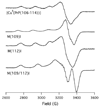Both Met(109) and Met(112) are utilized for Cu(II) coordination by the amyloidogenic fragment of the human prion protein at physiological pH
- PMID: 18778855
- PMCID: PMC2657601
- DOI: 10.1016/j.jinorgbio.2008.07.016
Both Met(109) and Met(112) are utilized for Cu(II) coordination by the amyloidogenic fragment of the human prion protein at physiological pH
Abstract
The prion protein is a ubiquitous neuronal membrane protein. Misfolding of the prion protein has been implicated in transmissible spongiform encephalopathies (prion diseases). It has been demonstrated that the human prion protein (PrP) is capable of coordinating at least five Cu(II) ions under physiological conditions; four copper binding sites can be found in the octarepeat domain between residues 61 and 91, while another copper binding site can be found in the unstructured "amyloidogenic" domain between residues 91 and 126 PrP(91-126). Herein we expand upon a previous study [J. Shearer, P. Soh, Inorg. Chem. 46 (2007) 710-719] where we demonstrated that the physiologically relevant high affinity Cu(II) coordination site within PrP(91-126) is found between residues 106 and 114. It was shown that Cu(II) is contained within a square planar (N/O)3S coordination environment with one His imidazole ligand (H(111)) and one Met thioether ligand (either M(109) or M(112)). The identity of the Met thioether ligand was not identified in that study. In this study we perform a detailed investigation of the Cu(II) coordination environment within the PrP fragment containing residues 106-114 (PrP(106-114)) involving optical, X-ray absorption, EPR, and fluorescence spectroscopies in conjunction with electronic structure calculations. By using derivatives of PrP(106-114) with systematic Met-->Ile "mutations" we show that the CuII coordination environment within PrP(106-114) is actually comprised of a mixture of two major species; one Cu(II)(N/O)3S center with the M(109) thioether coordinated to CuII and another CuII(N/O)3S center with the M(112) thioether coordinated to CuII. Furthermore, deletion of one or more Met residues from the primary sequence of PrP(106-114) both reduces the CuII affinity of the peptide by two to seven fold, and renders the resulting CuII metallopeptides redox inactive. The biological implications of these findings are discussed.
Figures











Similar articles
-
The copper(II) adduct of the unstructured region of the amyloidogenic fragment derived from the human prion protein is redox-active at physiological pH.Inorg Chem. 2007 Feb 5;46(3):710-9. doi: 10.1021/ic061236s. Inorg Chem. 2007. PMID: 17257012
-
Preferential Cu2+ coordination by His96 and His111 induces beta-sheet formation in the unstructured amyloidogenic region of the prion protein.J Biol Chem. 2004 Jul 30;279(31):32018-27. doi: 10.1074/jbc.M403467200. Epub 2004 May 15. J Biol Chem. 2004. PMID: 15145944
-
Specific binding modes of Cu(I) and Ag(I) with neurotoxic domain of the human prion protein.J Inorg Biochem. 2016 Feb;155:26-35. doi: 10.1016/j.jinorgbio.2015.11.015. Epub 2015 Nov 11. J Inorg Biochem. 2016. PMID: 26606290
-
Copper and the structural biology of the prion protein.Biochem Soc Trans. 2008 Dec;36(Pt 6):1288-92. doi: 10.1042/BST0361288. Biochem Soc Trans. 2008. PMID: 19021542 Review.
-
Copper and the prion protein: methods, structures, function, and disease.Annu Rev Phys Chem. 2007;58:299-320. doi: 10.1146/annurev.physchem.58.032806.104657. Annu Rev Phys Chem. 2007. PMID: 17076634 Free PMC article. Review.
Cited by
-
Copper-induced structural propensities of the amyloidogenic region of human prion protein.J Biol Inorg Chem. 2014 Jun;19(4-5):635-45. doi: 10.1007/s00775-014-1132-7. Epub 2014 Apr 16. J Biol Inorg Chem. 2014. PMID: 24737041
-
Spectroscopic and Theoretical Study of Cu(I) Binding to His111 in the Human Prion Protein Fragment 106-115.Inorg Chem. 2016 Mar 21;55(6):2909-22. doi: 10.1021/acs.inorgchem.5b02794. Epub 2016 Mar 1. Inorg Chem. 2016. PMID: 26930130 Free PMC article.
-
Redox control of prion and disease pathogenesis.Antioxid Redox Signal. 2010 Jun 1;12(11):1271-94. doi: 10.1089/ars.2009.2628. Antioxid Redox Signal. 2010. PMID: 19803746 Free PMC article. Review.
-
Identification of the minimal copper(II)-binding alpha-synuclein sequence.Inorg Chem. 2009 Oct 5;48(19):9303-7. doi: 10.1021/ic901157w. Inorg Chem. 2009. PMID: 19780617 Free PMC article.
References
-
- Taylor JP, Hardy J, Fischbeck KH. Science. 2002;296:1991–1995. - PubMed
-
- Fillit HM, O’Connell AW, Brown WM, Altstiel LD, Anand R, Collins K, Ferris SH, Khachaturian ZS, Kinoshita J, Van Eldik L, Dewey CF. Alzheimer Dis. Assoc. Disord. 2002;16:S1–S8. - PubMed
-
- Collins S, McLean CA, Masters CL. J. Clin. Neurosci. 2001;8:387–397. - PubMed
-
- Prusiner SB. Science. 1982;216:136–144. - PubMed
-
- Edkes HK, Wickner RB. Nature. 2004;430:977–979. - PubMed
Publication types
MeSH terms
Substances
Grants and funding
LinkOut - more resources
Full Text Sources
Research Materials
Miscellaneous

